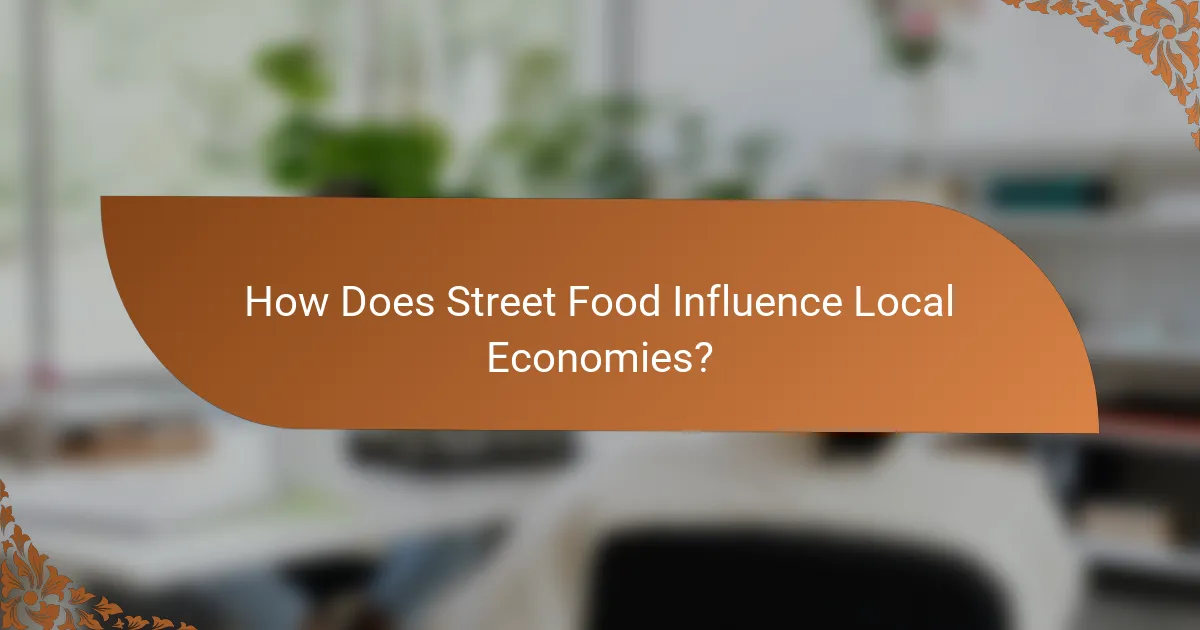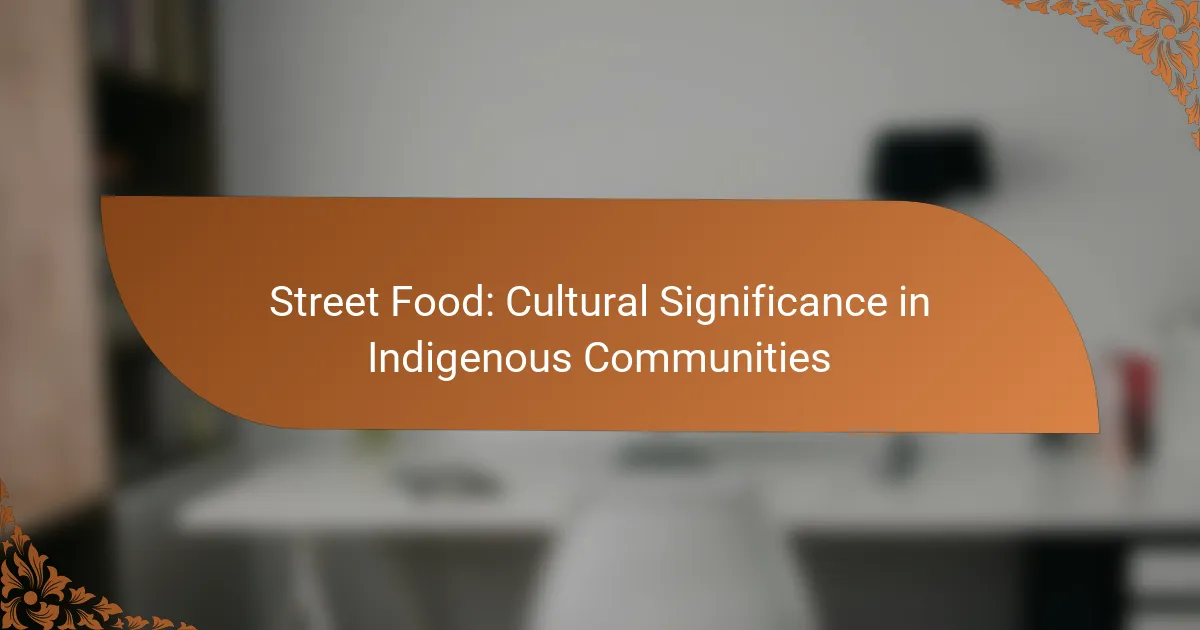Street food plays a crucial role in indigenous communities, serving as a vibrant expression of their cultural heritage and identity. By utilizing traditional ingredients and cooking methods, these culinary staples not only reflect local customs but also foster social interactions and communal practices. Additionally, street food contributes to local economies, creating jobs and supporting agriculture, thereby enhancing community development.

How Does Street Food Reflect Indigenous Culture?
Street food serves as a vibrant expression of indigenous culture, showcasing traditional ingredients, cooking methods, and communal practices. It reflects the unique heritage and identity of indigenous communities, often rooted in local customs and social interactions.
Connection to traditions
Street food is deeply intertwined with the traditions of indigenous communities, often featuring recipes passed down through generations. These culinary practices not only preserve cultural heritage but also serve as a means of storytelling, where each dish has historical significance and reflects the community’s values.
For example, in many indigenous cultures, certain foods are prepared during specific festivals or rituals, reinforcing the connection to ancestral practices. This continuity helps maintain a sense of identity and belonging among community members.
Representation of identity
Street food acts as a powerful representation of indigenous identity, showcasing unique flavors and cooking styles that distinguish one community from another. The ingredients used often reflect the local environment, emphasizing a deep connection to the land and its resources.
Moreover, the way street food is served and consumed can embody cultural norms and social structures. For instance, communal eating practices can highlight the importance of family and community ties, reinforcing a collective identity among indigenous peoples.
Community bonding
Street food plays a crucial role in fostering community bonding, as it often brings people together in shared spaces. Markets and food stalls become social hubs where individuals gather to enjoy meals, exchange stories, and strengthen relationships.
Participating in street food culture can also promote collaboration among local vendors, encouraging mutual support and economic resilience within indigenous communities. This communal aspect of street food not only enhances social ties but also contributes to the overall well-being of the community.

What Are Popular Indigenous Street Foods?
Indigenous street foods are culinary staples that reflect the cultural heritage and traditions of various communities. These dishes often utilize local ingredients and cooking methods, making them integral to the identity of the people who prepare and consume them.
Tacos de lengua (Mexico)
Tacos de lengua are a traditional Mexican street food made from beef tongue, which is slow-cooked until tender. The meat is then diced and served in soft corn tortillas, often topped with onions, cilantro, and salsa. This dish is popular for its rich flavor and is commonly found at street vendors and taquerias across Mexico.
When enjoying tacos de lengua, consider trying different salsas to enhance the taste. Pairing with a refreshing drink like agua fresca can also complement the meal. It’s advisable to eat them fresh to fully appreciate the flavors and textures.
Pani puri (India)
Pani puri is a beloved Indian street snack consisting of hollow, crispy puris filled with a spicy mixture of tamarind water, chickpeas, and potatoes. Vendors often prepare these on the spot, ensuring a burst of flavor with every bite. This dish is especially popular in North India and is known for its vibrant taste and refreshing qualities.
To enjoy pani puri, it’s best to eat them quickly after filling to maintain their crispiness. Experimenting with different fillings or spice levels can enhance your experience. Be cautious with street vendors; choose those with a high turnover to ensure freshness and hygiene.
Arepas (Venezuela)
Arepas are a versatile Venezuelan street food made from ground maize dough, which can be grilled, baked, or fried. These round patties can be split open and filled with a variety of ingredients, such as cheese, meats, or avocado, making them a popular choice for breakfast, lunch, or dinner. Arepas are not only delicious but also a symbol of Venezuelan culture.
When trying arepas, look for vendors who offer a range of fillings to suit your taste. They are often served with sauces like guasacaca, a creamy avocado sauce, which adds a delightful flavor. Keep in mind that arepas can vary in thickness and preparation style, so sampling different versions can be a rewarding experience.

How Does Street Food Influence Local Economies?
Street food significantly influences local economies by creating jobs, attracting tourists, and supporting local agriculture. These factors contribute to economic growth and community development, particularly in indigenous regions where traditional foods are celebrated.
Job creation
Street food vendors play a crucial role in job creation within local communities. They provide employment opportunities not only for the vendors themselves but also for those involved in food preparation, supply chain logistics, and even marketing. In many cases, a single food stall can create several jobs, fostering economic stability.
Moreover, street food operations often require minimal startup costs compared to traditional restaurants, allowing more individuals to enter the workforce. This accessibility can lead to a diverse range of culinary offerings, enhancing the local economy.
Tourism attraction
Street food serves as a major attraction for tourists, drawing visitors eager to experience authentic local cuisine. Unique street food offerings can enhance a destination’s appeal, encouraging longer stays and increased spending in the area. Festivals and food markets centered around street food often become focal points for tourism, showcasing cultural heritage.
For instance, cities known for their street food, such as Bangkok or Mexico City, see significant tourist traffic, which benefits local businesses and the economy. Promoting these culinary experiences can lead to a sustainable tourism model that supports local vendors.
Support for local agriculture
Street food vendors often source their ingredients from local farmers, creating a symbiotic relationship that supports regional agriculture. This practice not only ensures freshness and quality but also helps sustain local farming communities. By prioritizing local produce, street food contributes to the economic viability of agriculture in the area.
Additionally, this connection can promote seasonal eating and reduce transportation costs, benefiting both vendors and consumers. Encouraging street food vendors to collaborate with local farmers can strengthen community ties and enhance food security.

What Are the Health Implications of Street Food?
Street food can have both positive and negative health implications, depending on its nutritional value and safety practices. While it often provides affordable and accessible meals, concerns about hygiene and nutritional content can impact public health.
Nutrition considerations
Street food varies widely in nutritional quality, often influenced by local ingredients and preparation methods. Many options are rich in carbohydrates and fats, which can lead to an imbalanced diet if consumed excessively. It’s essential to seek out meals that include vegetables, lean proteins, and whole grains to ensure a more balanced intake.
Consideration of portion sizes is also important. Street food servings can be large, so sharing meals or opting for smaller portions can help manage caloric intake while still enjoying diverse flavors.
Food safety practices
Food safety is a critical concern with street food, as improper handling can lead to foodborne illnesses. Vendors should adhere to basic hygiene practices, such as washing hands, using clean utensils, and keeping food at safe temperatures. Observing how food is prepared can provide insight into the vendor’s commitment to safety.
Consumers can take precautions by choosing busy stalls with high turnover, as this often indicates fresher ingredients. Additionally, opting for cooked items over raw foods can reduce the risk of contamination.
Impact on public health
The impact of street food on public health can be significant, particularly in urban areas where it is a primary food source. High consumption of unhealthy street food can contribute to rising rates of obesity and related diseases, such as diabetes and heart disease. Public health campaigns may be necessary to educate vendors and consumers about healthier options.
Moreover, local governments can play a role by implementing regulations that ensure food safety standards are met, which can help mitigate health risks associated with street food. Encouraging the sale of nutritious options can also improve community health outcomes.

How Can Street Food Promote Cultural Exchange?
Street food serves as a vibrant medium for cultural exchange by allowing diverse communities to share their culinary traditions and flavors. Through food, people can experience and appreciate the heritage, customs, and stories of different cultures, fostering understanding and connection.
Fusion cuisine examples
Fusion cuisine blends elements from different culinary traditions, creating innovative dishes that reflect cultural diversity. For instance, Korean tacos combine traditional Korean ingredients like bulgogi with Mexican tortillas, showcasing how street food can merge flavors and techniques from various backgrounds.
Another example is the Vietnamese banh mi, which incorporates French baguettes with Vietnamese fillings, illustrating the influence of colonial history on local cuisine. These fusion dishes not only tantalize taste buds but also highlight the interconnectedness of global cultures.
Community events and festivals
Community events and festivals centered around street food provide platforms for cultural exchange, bringing together vendors and visitors from various backgrounds. These gatherings often feature diverse food stalls, cooking demonstrations, and cultural performances, allowing attendees to engage with different traditions.
For example, food festivals in cities like New York or London often celebrate international cuisines, where visitors can sample dishes from around the world. Participating in these events encourages appreciation for cultural diversity while supporting local businesses and fostering community spirit.
